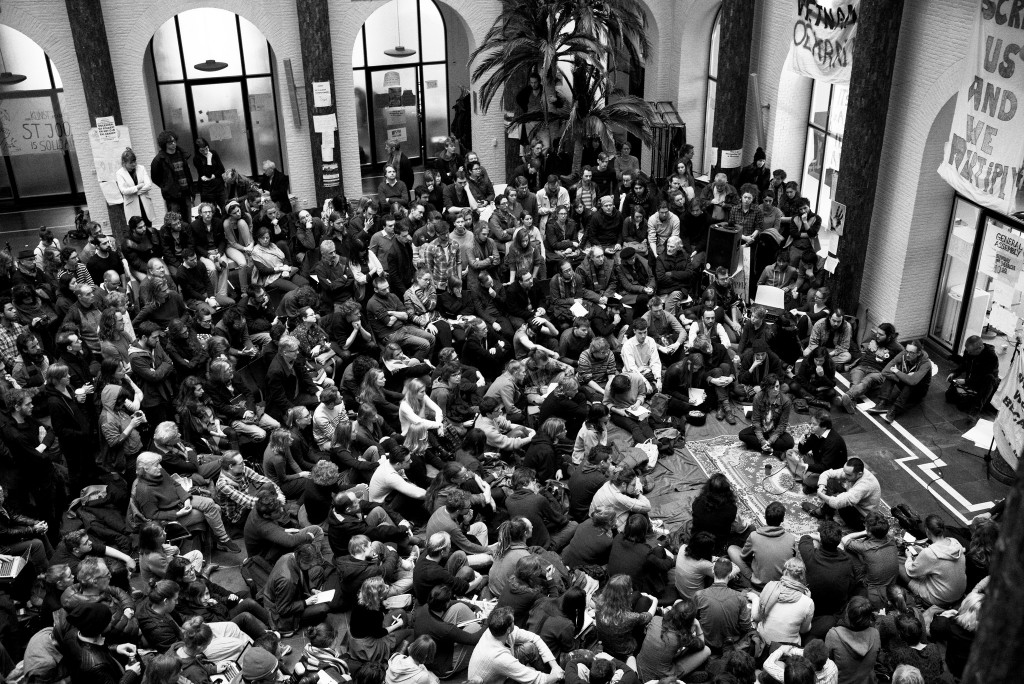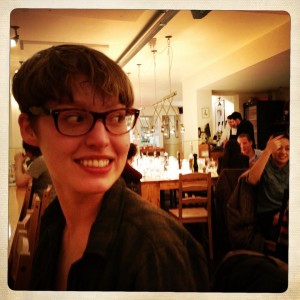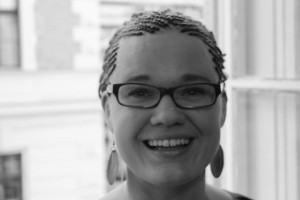At first, it did not seem that the student protests at the University of Amsterdam (UvA) looked very different from the wave of movements against financialization of higher education that have swept over Europe in recent years. What makes the Maagdenhuis occupation different, and possibly more challenging, however, is the fact that students have been joined by a large number of staff members, including from the – mostly outsourced – support staff.
The demands of the joint movements, the ’New University’ and the ’Rethink UvA’ campaigns run by UvA students and staff, respectively, explicitly target neoliberal higher education policies in the Netherlands, ranging from the axing of “unprofitable” degrees to increasingly “flexible” labor standards and imposed teaching standards. The general dissatisfaction is also connected to a complete lack of transparency and democracy in the management of the university, spiced up by shady financial speculation. Thus far, the movement, demands the radical democratization of the university, has provided students and staff with a strong feeling of community that is ubiquitously absent in other UvA premises.
First, some words about the recent history of the movement. Long-term grievances of staff and students were ignited in November when big budget cuts targeting the Humanities faculty were announced – these cuts would have led to merging some study programs and the cancellation of other unique programs. Moreover, the historical building Bungehuis, the home-base of the faculty, was sold as part of the university’s real-estate centralization plan (a Dutch real estate company recently announced that the fate of the Bungehuis is to become an elite “Soho House Club” for the entertainment industry). The Humanities Rally, where the protest “began” quickly expanded to demand the review of the university’s financial allocation models and for students and staff to get a say in the management of their faculty. It quickly became clear that these grievances were shared by other faculties, as well.
The resulting wave of occupations and protests have now continued for more than a month. In the early morning of February 13 members of The New University movement occupied the Bungehuis, which led to the UvA executive board threatening fine of 100.000 euro per person per day, and finally after 11 days, their eviction by the military police. The violent scenes from the eviction and the arrest of 45 students and one staff member created general outrage throughout the university, and the ensuing protest march the next day resulted in the occupation of yet another building, the Maagdenhuis. The Maagdenhuis is not only symbolically significant because it harbours the offices of the university’s central board, but also because of a sense of reliving history: the Maagdenhuis resonates among previous generations who occupied the very same building in 1969, when students also protested against authoritarian management structures in the university.
From a historical perspective, the neoliberal policies of UvA do not only reflect the development of the university, but also the steady privatization of other spheres of life in the Netherlands, the most notorious example being the health care system that now requires all residents to hold private health insurance. Indeed, the university has been engaged in real estate speculation and investment since the early 1990s. In 1992 the Executive Board of the UvA established the UvA Holding BV, of which the university is the sole shareholder, ’to develop and implement market-oriented activities, namely commercial activities that are not core activities of the university but are directly related to them’. In the meanwhile, more and more management structures of the university have been handed over to external “experts”, a bulk of research is financed (and hence influenced by) external grant money, and students have been turned into consumers of the UvA brand and education is increasingly treated as a commodity.
The most obvious, and perhaps the most important, difference of the movement today is the way in which a proportion of the staff, including some cleaners and janitors, joined the students in the struggle, thereby adding an important and heavy-weight critique of the way in which knowledge is produced and commodified. The academic “celebrity” endorsements by names such as Judith Butler, Jacques Ranciere, Noam Chomsky, Alain Badiou and Etienne Balibar, to name a few, further boosted the confidence of the movement, as did the anarchist anthropologist David Graeber in his guest lecture at the Maagdenhuis.

While such a level of endorsement gave much-needed stamina and self-confidence to the movement, important challenges remain. Although the protests’ clear critique of financialization attracts many, it acts as a deterrent for just as many more, highlighting the fact that people’s relationship with neoliberalism is not as straightforward as we might wish – rather, it is a reality to which people are awakening as we are writing these lines. Indeed, the potential of the movement, says Erella Grassiani, a teacher and researcher of anthropology at the UvA, is to shake off the internalized attitude to close the door of your office and continue with making all the deadlines that you have, and to question the constant feeling of pressure, dissatisfaction and insecurity that are so characteristic of neoliberal higher education. Also, as Christopher Linden notes, the cultural and academic program that the New University protesters put together every day, remains more interesting and thought-provoking than those offered by the “real” university in a month.
Although the movement faces multiple challenges – from protest fatigue to being coopted by other structures – the change has, already, been monumental. Find a coffee machine at UvA, and nearby you will find people discussing the occupation – indeed, the protest has trickled down and sparked conversations and debates over what it means to be part of an academic community today. As Grassiani points out: ”We are in a point in time where we actually believe and can imagine the university looking differently. That there is actually a chance that we will be able to do our work differently, that we can have a real say in the way the university, our teaching and research is organized” – emphasizing that the “we” stands for students and staff alike.
Willy Sier (left) and Annastiina Kallius (right) are PhD Candidates at University of Amsterdam, Department of Anthropology.



